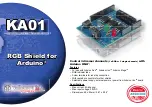
4
JTAG Interface
The Joint Test Action Group (JTAG) port is an IEEE standard that defines a Test Access Port and
Boundary Scan Architecture for digital integrated circuits and provides a standardized serial interface
for controlling the associated test logic. The TAP, Instruction Register (IR), and Data Registers (DR)
can be used to test the interconnections of assembled printed circuit boards and obtain manufacturing
information on the components. The JTAG Port also provides a means of accessing and controlling
design-for-test features such as I/O pin observation and control, scan testing, and debugging.
The JTAG port is comprised of four pins:
TCK
,
TMS
,
TDI
, and
TDO
. Data is transmitted serially into
the controller on
TDI
and out of the controller on
TDO
. The interpretation of this data is dependent
on the current state of the TAP controller. For detailed information on the operation of the JTAG
port and TAP controller, please refer to the
IEEE Standard 1149.1-Test Access Port and
Boundary-Scan Architecture
.
The TM4C1294NCPDT JTAG controller works with the ARM JTAG controller built into the Cortex-M4F
core by multiplexing the
TDO
outputs from both JTAG controllers. ARM JTAG instructions select the
ARM
TDO
output while JTAG instructions select the
TDO
output. The multiplexer is controlled by the
JTAG controller, which has comprehensive programming for the ARM, Tiva™ C Series
microcontroller, and unimplemented JTAG instructions.
The TM4C1294NCPDT JTAG module has the following features:
■ IEEE 1149.1-1990 compatible Test Access Port (TAP) controller
■ Four-bit Instruction Register (IR) chain for storing JTAG instructions
■ IEEE standard instructions: BYPASS, IDCODE, SAMPLE/PRELOAD, and EXTEST
■ ARM additional instructions: APACC, DPACC and ABORT
■ Integrated ARM Serial Wire Debug (SWD)
– Serial Wire JTAG Debug Port (SWJ-DP)
– Flash Patch and Breakpoint (FPB) unit for implementing breakpoints
– Data Watchpoint and Trace (DWT) unit for implementing watchpoints, trigger resources, and
system profiling
– Instrumentation Trace Macrocell (ITM) for support of printf style debugging
– Embedded Trace Macrocell (ETM) for instruction trace capture
– Trace Port Interface Unit (TPIU) for bridging to a Trace Port Analyzer
See the
ARM® Debug Interface V5 Architecture Specification
for more information on the ARM
JTAG controller.
207
June 18, 2014
Texas Instruments-Production Data
Tiva
™
TM4C1294NCPDT Microcontroller
















































